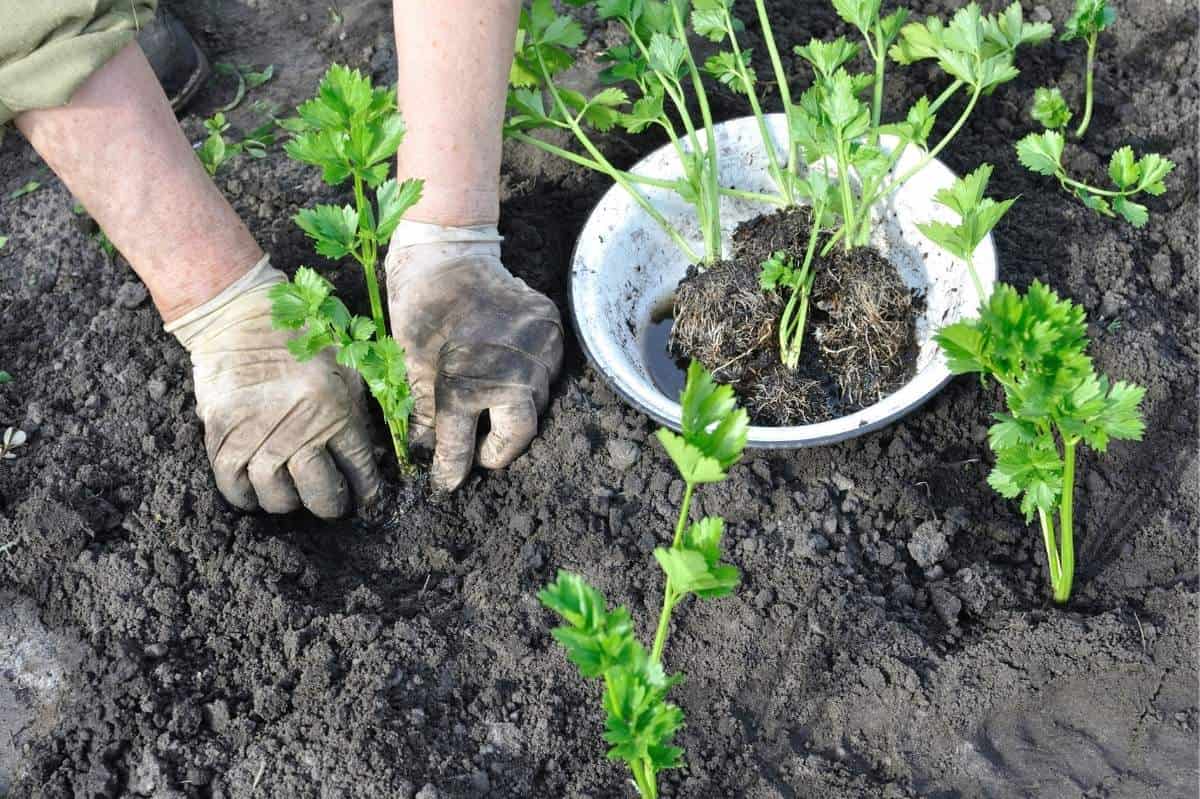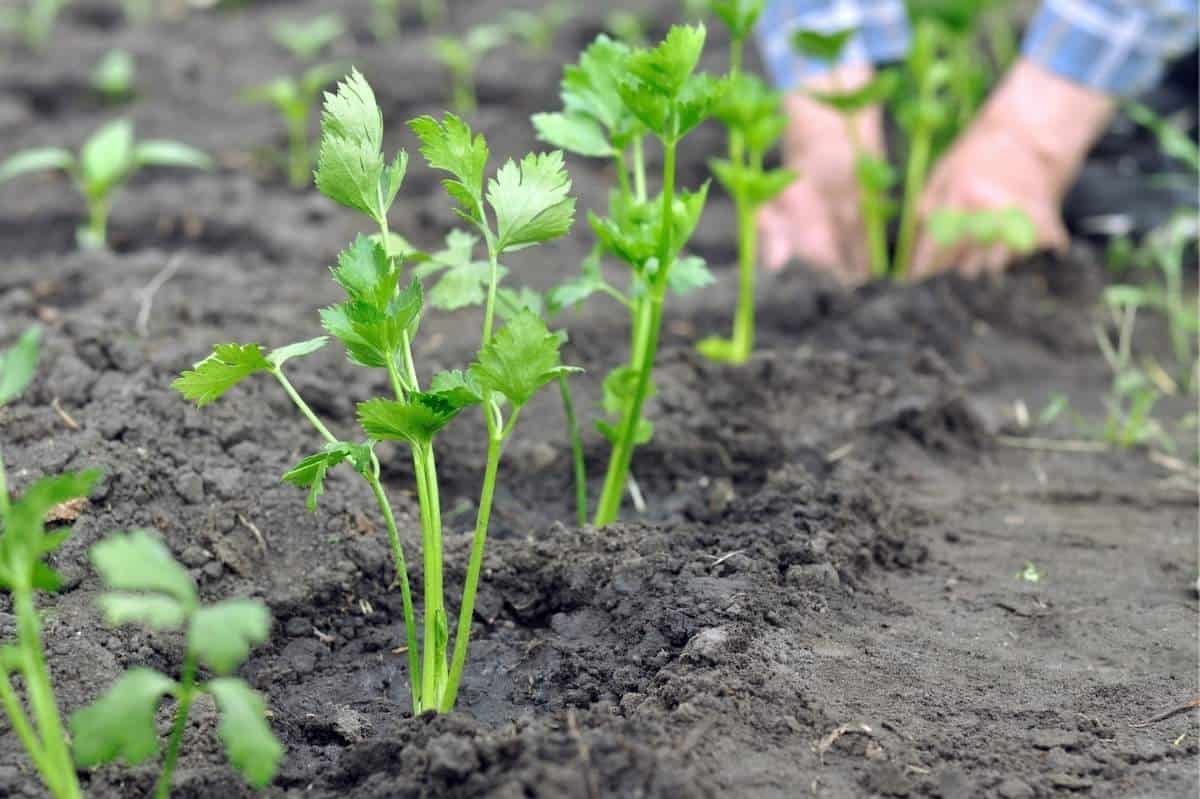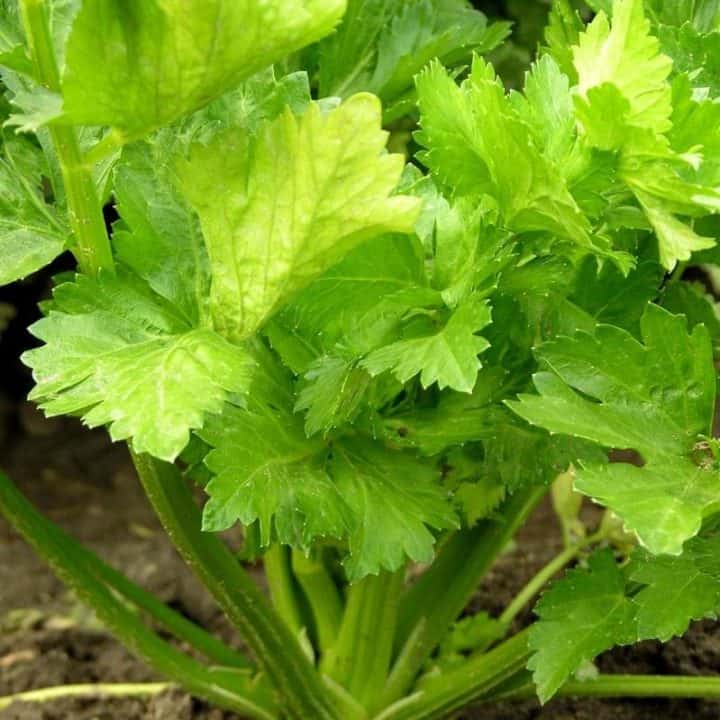Download Printable Celery Growing Guide »
Celery might not be the first plant you think of when you go to order seeds, but we’re here to convince you to give it a try! Homegrown celery has a wonderful taste that adds tons of flavor to soups, salads, and stews. It’s a great crop for the garden because it thrives in cool weather—so once your tomatoes and cukes have stopped producing, you can harvest crisp and sweet celery to snack on!
With the right conditions—cool weather and moist soil— celery is a breeze to grow, and we think everyone should give it a try!

Table of Contents
Why should I grow celery?
Store-bought celery doesn’t hold a candle to the taste and flavor of homegrown celery—it’s almost like it’s an entirely different vegetable! Homegrown celery is sweet, crunchy, and packed full of nutrients.
Which celery should I grow—trenching or self-blanching?
There are two types of celery you can grow, but one requires a bit more work than the other:
- Trenching Celery: This type of celery requires you to mound soil up against the stems to produce crisp, light color stems. To make this easier, some gardeners grow this type of celery in trenches—hence the name!
- Self-Blanching Celery: This type of celery doesn’t require soil mounding, making it much easier to grow!

When does celery grow best?
Celery prefers cooler weather, and it takes about 16 weeks of consistently cool weather to have good results. Too hot of growing conditions can lead to bitter and stringy celery. In cool and mild climates, you can sow celery in early spring for harvest throughout the summer and fall. In hotter climates, celery works well as a fall crop. In mild climates, you can also plant celery in early fall for a winter crop.
Is it true that I can grow celery from scraps?
Sure can! When you purchase a bundle of celery from the grocery store, slice off the base and then place it, cut side up, in a shallow cup of water in a sunny window. After about a week, you’ll start to see small leaves poking out from the middle of the cut side. Once those leaves are up, transfer the celery to a pot or into your garden, and cover the entire base with loose soil—just leave the small leaves above the soil.

How do I grow celery from seed?
Since celery is a relatively slow-growing veggie (it’ll take about 16 weeks from seed to harvest), we recommend starting growing celery from seedlings—either purchased or your own homegrown seedlings.
Growfully Protip
Some folks in cooler climates do have good luck direct sowing celery seed in the garden in the summer for fall and winter harvests.
Can I grow celery from seedlings/starts?
We recommend growing celery from seedlings, but finding celery seedlings or starts at your local garden center might be tricky. Here’s how to grow them yourselves:
- Celery seeds are tiny seeds that prefer moist, loose, rich soil. Sow seeds by placing the tiny seeds on top of the soil, lightly tamp down, and then just barely cover with fine soil. Celery seeds need light to germinate.
- Water your delicate celery seeds by using a spray bottle to dampen the top of the soil every day.
- You can also wrap plastic wrap around the seed tray or use a humidity dome to help retain humidity.
- Celery seeds take a while to germinate—up to 21 days, so be patient! When the seeds do germinate, remove the plastic wrap, and keep the seedlings damp while growing.
- Make sure to harden off your celery seedlings by exposing them to gentle a gentle breeze and dappled sunlight before transplanting them out in the garden.
- Transplant your seedlings to the garden, spacing them about 1 foot apart. Keep the celery well-watered!
Download Printable Celery Growing Guide »

When do I plant celery?
In cooler climates, for a spring or summer harvest, start seeds indoors 8-10 weeks before your last frost date. In warmer climates, start your celery seeds indoors in mid-summer for planting out in late summer to early fall.
How long does celery take to grow?
Celery requires a long growing season. It takes about 16 weeks to go from germination to harvest.

What do celery plants need to thrive?
Celery plants are relatively easy to grow given the correct conditions. Here are some important celery needs to remember:
- Plenty of water: To keep celery crisp and reduce stringiness, it’s important to give celery enough water. Celery has shallow roots that require frequent, even watering. You can help keep even moisture by using mulch around the base of your garden celery.
- Protection from the summer heat: If you live in a hot climate, you’ll want to grow celery during your most mild months. Celery can also tolerate partial shade in hot climates, especially during the hottest part of the day.
- Fertilize regularly: Celery are heavy feeders. A well-maintained bed with plenty of organic matter, composted manure, or compost is typically adequate, but if your celery is lackluster, a regular addition of nitrogen fertilizer can help.
- Keep an eye on micronutrients: Celery is susceptible to magnesium and calcium deficiencies. You can help avoid this by using organic soil amendments like azomite—which adds over 70 different trace minerals to the soil.

Can I grow celery in containers?
Thanks to its shallow roots and vertical growth, celery is an excellent option for growing in containers! Make sure to stick with self-blanching celery varieties. You’ll also want to make sure to keep the moisture even when growing in containers
What should I plant near celery?
Strong-smelling plants like marigolds, nasturtiums, and members of the onion family can serve as natural pest control by repelling the bugs that can harm celery.
Celery can help repel pests that enjoy munching on brassicas, such as cabbage or Brussels sprouts, as well as those that like to feast on bush beans. They can discourage pests that enjoy spinach and tomatoes, too. Planting celery near any of these can help protect your vegetables.
How do I harvest celery stalks?
You can harvest individual celery stalks by cutting them off, from the outside in. The plant will keep producing for a long while if you stick to harvesting individual stalks.
If you prefer, you can also harvest whole plants by cutting the plant off about an inch above the soil line—this will allow the plant to regenerate and grow more celery!

Troubleshooting
Celery is pretty easy to grow if you keep it well watered and grow it during cool months in your area. But if you’re having problems, let’s solve them! Here are a few common celery issues:
Slugs: Celery is mostly pest-resistant, but in the cool, wet climate that celery enjoys, slugs are pests that sometimes target celery. Pick off any slugs you see, and trap others by burying shallow cups or empty tin cans of beer just below the soil surface. The slugs are attracted to the beer, fall into it, and then you can dispose of the slugs.
Yellowing Leaves: Yellowing leaves is a sure sign that your celery plant is stressed. Common issues that cause yellowing leaves are overwatering, low nitrogen, and heat stress.
Help! My Celery is Bitter! Bitter celery indicates that it’s gotten too warm for your celery plant to be happy. Try giving it a little bit of shade during the hottest part of the day—if that doesn’t remove the bitterness, it’s time to pull the plants and start over again when the weather isn’t so toasty.

Download Printable Celery Growing Guide »

Top 5 Tips for Growing Celery
Celery is a cool-weather plant that thrives in moist, rich soil. Learn how to grow celery—even if you don’t have a green thumb! Download printable celery growing guide »
Materials
- Celery seedlings
Tools
- Rich, well-draining soil
- Celery growing guide
Instructions
- Start with seedlings. Thanks to its very long growing season (16 weeks!), we recommend starting with seedlings, rather than direct sowing celery seeds.
- Water often. Celery has shallow roots and requires plenty of water to keep its characteristic crispness. Water frequently and evenly.
- Use mulch. Mulch will help keep the soil moist and cool enough to promote celery growth.
- Fertilize well. Celery uses lots of nutrients, so be sure to add compost to the soil, and consider a regular application of nitrogen-rich fertilizer.
- Amend the soil. Celery is prone to magnesium and calcium deficiencies, so use an organic soil amendment like azomite.







